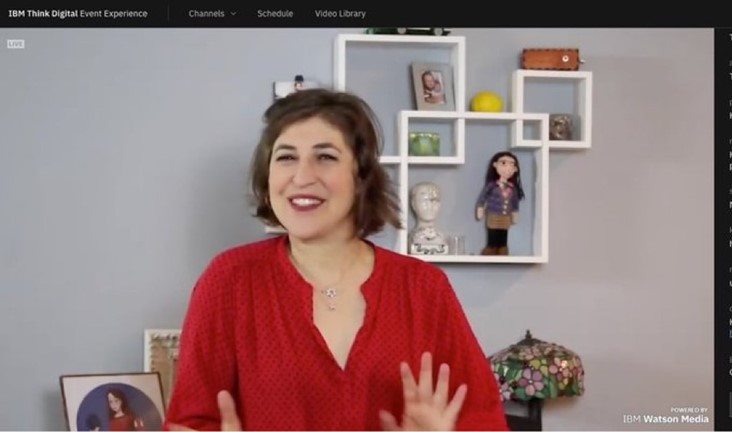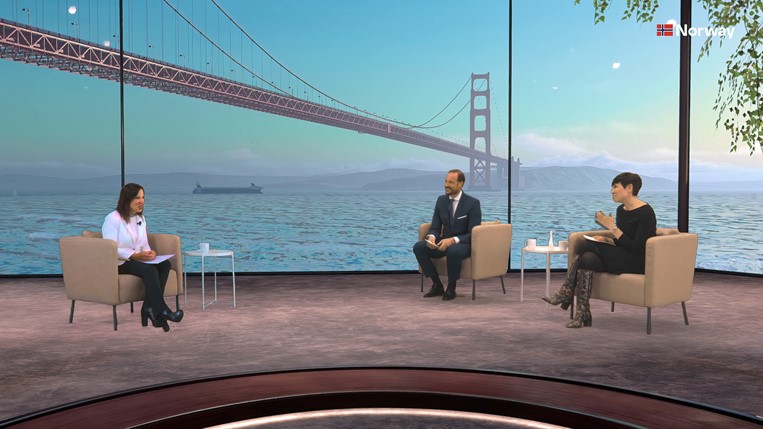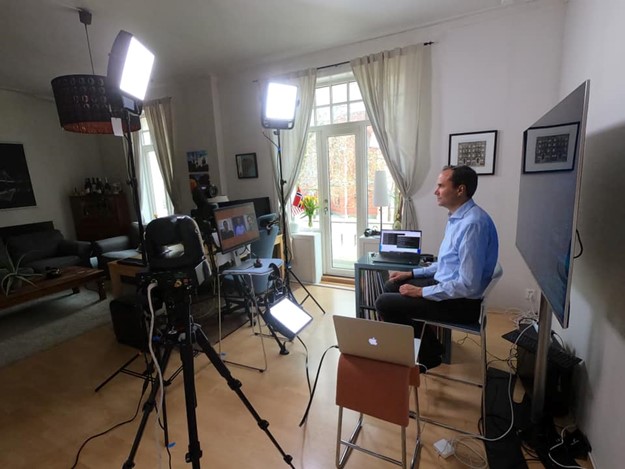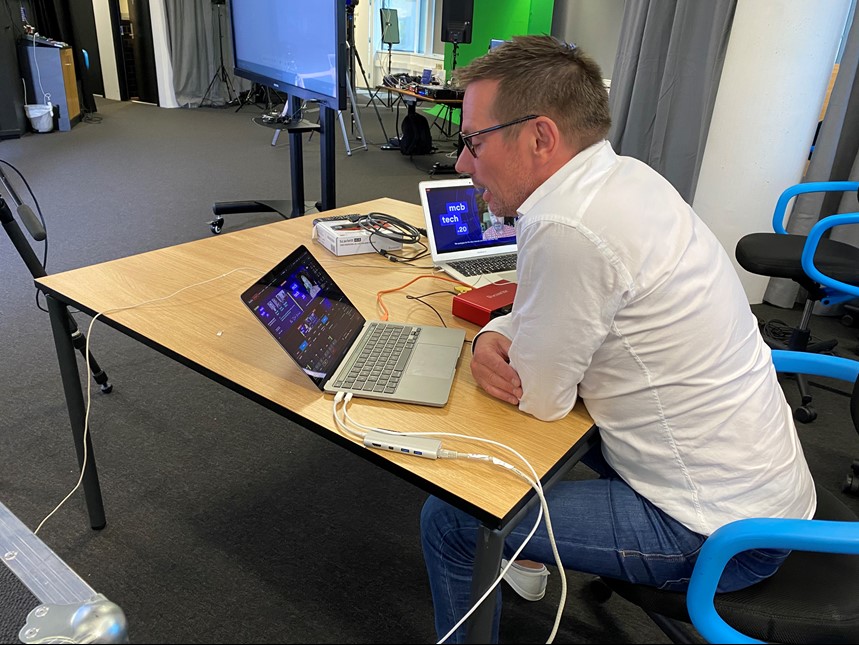For most of us, we started from a point pre covid where the majority of events took place physically, with an occasional streaming session on selected happenings. Meetings on Zoom or Teams were indeed part of everyday life before Covid. However, most of our meetings took place in person, and many of us were boarding the red-eye (also known as "the pajamas flight") between cities to attend meetings on a regular basis. Covid changed all of this.
What we have seen throughout the last year is not only a massive shift in how we communicate, but a substantial amount of innovation and much-needed change in new technology and tools to meet the new normal; A way of life where we desire greener conversations, less travel and find more sustainable ways of bringing people together.
Here are ten things we learned about communication during covid
1) Everybody is a producer now.
No doubt, the fact that everyone became familiar with Teams, Zoom, and other online tools lowered the threshold to host online meetings and organize webinars. It is easy, quick, and in many ways simpler than physical events. One does not have to think about logistics, travel, or serving your audience coffee or food. And there is no tidying up after.
But just because you can, does not mean you have to. We can surely agree that the performance quality, especially in the first weeks and months of Covid, was highly varying and often unpredictable. All events were introduced with a line from Adele: “Hello, can you hear me?"
Many webinars and online seminars were set up because it was feasible and achievable and because the audience was easily accessible. They did not necessarily have quality content. If we have learned anything over the last year, it is that content is king. Still.
Covid, with all the webinars, has not only pushed digital innovation and adoption but made people realize how difficult communication really is.
2) This is innovation. Let's fail more.
But, there is something democratic and open in the fact that everyone can run their events and reach an audience. And there is a lot of learning. The competence gained from using new tools and solutions (share screen, remember to mute, use waiting rooms, etc.) is highly valuable. And, one might add, much needed.
I personally logged in to a webinar 10 min before start and – much to my surprise – came straight into the meeting just to observe the speaker putting on her makeup, straightening her bra, and doing her zen as part of her preparation. Entertaining, one might add. And we have all seen the YouTube videos of the executives forgetting to turn off their web camera, getting up from their chair, revealing that they – other than a shirt and tie – are in their underwear.
And let's also take a look in the mirror. My company typically hosts around 90 events every year. They are all moved online now, and like everyone else, we have had a steep learning curve. Let's just say that the annual bloopers tape for our Christmas party was extra rich this year...
But hey – this is what innovation really is.
3) Shorter attention span
Online audience patience is much, much less than the perseverance we have in a physical meeting. Everything needs to be sharper, shorter, and to the point. Your audience will likely be multitasking as they listen to your webinar. It is so much harder to keep their attention.
Communication must work both ways. It is a two-way road. And easy to forget when one is operating muting, spotlight, screen sharing, and chat rooms all at the same time. The lesson here is to put at least the same amount of energy and attention to your content and message as to your playout.
To tell stories in the online event format is very different. It requires other techniques, new dramaturgy, additional presenting skills, and attention to storytelling. An excellent investment is to sign up for a class that teaches online communication. I would promptly recommend SpeakLab.

Photo: Speaklab
4) You need to nail the streaming part.
As so many of us have signed up for webinars and online seminars, the value of excellent streaming is obvious. The one-camera-total-at-a-distant shot does not do the trick anymore. It's just not good communication. As we enter a post covid era with expectations of more hybrid events, the streaming setup will make or break your success.
5) It is increasingly tough to meet audience expectations.
After the initial first Covid weeks of fumbling and online clumsiness, we all got better. The quality of online events became increasingly professional. Better productions, quality sound, multiple cameras, visuals, and layovers were all combined for a more professional look and feel.
With that, the audience became slightly more critical, and in their heads, conceptually, started to compare to broadcast quality. Things that never caused anyone to raise an eyebrow now spurred negative feedback.
Don't be discarded – it only means you are getting closer to perfection.
6) Added intimacy
This is the year when great keynote speakers, international thought leaders, and celebrities have invited the audience into their homes.
No doubt, experiencing great speakers in person on international stages at different conferences makes up for a unique experience, even though they are up on the stage and you are somewhere in the auditorium as part of the audience. Still – you are there, and there is a certain level of personal closeness to just being there. So one would surely assume that this is a dimension difficult to replicate online, and that the distance between a celebrity speaking and me sitting somewhere else watching on my laptop would add to the sense of remoteness and lack of authenticity. But in my experience, the opposite can also happen.
I watched IBM Think last year – online – and saw great speakers like Amal Clooney, Imogen Heap, and Mayim Bialik – live from their living rooms, surrounded by family photos and personal things, with Mayim Bialik apologizing for her cat constantly jumping in the frame.


Screenshot from IBM Think session with Mayim Bialik, live from her home.
A lesson learned is that online meetings can still certainly give a personal touch and a sense of togetherness.
7) The Don'ts
Unless you have absolutely brilliant, one of a kind, to-die-for content:
A: Do not email the link to your webinar or event to your audience one week in advance and expect them to turn up, unless you also send them a reminder 10 min before the event starts – with the link, or have sent them an invitation download for their calendar, including a link, easy to locate.
B: Do not expect your audience to sign up for different platforms, install applications, watch instruction videos, study tutorials and go through extensive and voluminous sign-on processes to listen in to a webinar or conference – unless you are utterly sure you have excellent content. It is a bother.
C: Do not ask for too much private information. Yes, it's tempting to know as much as possible about the people who sign up, but as we all are increasingly careful giving away our personal information, rethink if you really need to know people's age, gender, title, preferences, and so on just for your online breakfast webinar. It is a signup killer. And – collecting more data than you need might even be a breach of GDPR.
D: Do not underestimate the positive effect of seeing faces, especially for the speaker. The Zoom "meeting" platform can be preferable over the "webinar" tool, for example, especially for smaller seminars. It adds intimacy and a feeling of attending together with others. If appropriate, encourage the audience to keep their cameras on (this can, however, be difficult when events are recorded).
E: Don't expect the same attendance as for your physical events. It’s a plethora of choices and things to attend – online – and one barely remembers what one signed up for. The no-show group can be significant. Nailing the above A to D can help.
8) Exploring not only the digital space but also the virtual.
Virtual studios are no longer limited only to broadcasters. They are still not part of everyday solutions for most of us, but we have witnessed a commodification of virtual solutions and meetings during covid, bringing seminars and conferences to a whole new level. And no – it's not "just another screen." The virtual experience adds a new dimension – the illusion and feeling of sitting in the same room even as we are miles apart. In the Norwegian Media Cluster, several projects are looking into this now. How can virtual communication cater to a different experience and feeling of being together? How can we make available a low-cost, easy-to-use virtual studio as a service for the broader market?
Here are a few examples:
His Royal Highness, Crown Prince Haakon of Norway, virtually visited California recently, courtesy of Media Cluster Company Myreze. Together with the Norwegian Minister of Foreign Affairs, Ine Eriksen Søreide, the CEO of Innovation Norway, Håkon Haugli, and other representatives from Norway, the Crown prince was “teleported'' live to San Francisco for a visit to Universities Berkley and Stanford, and to discuss matters of environment and sustainability with Nancy Pelosi.

Photo: Myreze
To be fair, this was an utmost complex and challenging operation, entirely out of the ordinary. It was streamed live from both San Francisco and Oslo, where the logistics of bringing in people from all parts of the world was done with perfect timing in a highly advanced technical setup. But do note what Håkon Haugli, CEO of Innovation Norway, said;
– The technology is impressive and provides for an experience of actually being in the same room, even though we are physically located in different parts of the world.
Another great example:
Media Cluster Company Vizrt actually set up their own TV station overnight as Covid started. Like so many others, they suddenly lost important arenas for interaction and dialogue with customers. Vizrt is a world-leading software company that creates visual storytelling tools for 4000 TV stations worldwide. Still, they are not in any way a TV station themselves.
But from a green screen studio and control room in the Bergen office, Chris Black, Head of Brand and Content in Vizrt, and his colleagues, set up a fully remote, high quality, and distributed production, harnessing the power of NDI.
Vizr.TV was born.
In this way, not only could they reach out to the 700 employees all over the world, but they could also bring in colleagues located in Paris, Amsterdam, or Miami into the same virtual space to perform product demonstrations and virtual set shows, and live stream it to customers everywhere.

Chris Black, Vizrt, from the early days of Vizr.TV
Necessity is the mother of innovation. Initially, the studio was set up in Chris's living room at home, with the control room located at a colleague's house on the other end of town. A third Vizrt colleague connected the systems in the cloud from his control room in Paris. They would utilize a green screen in Austria for virtual set shows and leverage a network of production switchers distributed at peoples' homes. That's innovation.
And a third example: The mcb tech conference.
For the second year, the Norwegian technology conference, mcb tech, is brought to the audience from a virtual studio in Media City Bergen. Here a snippet from mcb tech .20, from a Myreze virtual studio:
Make sure to tune in on 10 June for mcb tech .21, to see if we actually succeed in teleporting our international guests and speakers to our virtual studio for a conversation on future and tech.
9) New technology, new opportunities
The opportunities and innovations lying ahead are formidable. Covid has really pushed innovation on new tech and solutions a quantum leap forward. A study from McKinsey shows that Covid has accelerated the adoption of digital technologies by several years. It's impressive to see how event organizers have turned their business around, adapted, and have been at the frontier of online events this last year. Media Cluster Company Kulturoperatørene has had one of their busiest years ever and has truly forced the boundaries of what can be done within reasonable limits and costs, using new tech and tools, as well as creativity and innovation mindset.

Øyvind Storheim, Kulturoperatørene, producing from MCB Media Lab. (Photo: Media City Bergen)
What we also need to rethink is distributed conferences and connected venues (check out TrippelM). It is arguably not sustainable to travel across the world to attend meetings and conferences. However, one can still meet up at various, closer-to-home locations, connect the different venues in a hybrid model, and hence limit travel.
New solutions for production, workflow, and distribution will be less complex and complicated. Networks like 5G and NDI (video transferred over IP easy and efficient in high quality/low latency) will be game-changers and open for more accessible ways to connect from different parts of the world, meet in virtual spaces and interact in real-time. It will be increasingly important to access cloud-based tools for production economically and efficiently, and develop platforms that can combine and integrate different solutions.
The full, virtual world is yet to be explored. What can be done with immersive technologies is immense and only limited to the imagination. Combining VR, AR, and interactivity opens a whole new experience. We have barely touched the surface in experimenting with virtual avatars, teleportation, holograms, and volumetric video (check out Holocap).
Then – add AI, and we can bring it all to the next level.
10) Digital and virtual will not replace physical
We are all pretty convinced that "everything will be hybrid" from now. And we should all strive to travel less. But other than that, most of us agree that online meetings rarely replace the value of physical meetings, contact and interaction. It is tough to do innovation on Zoom or Teams. Physical sessions provide flexibility. One is free to move around, use the whiteboards, outline the creative ideas.
Trust between people is more notable in a physical meeting, and it provides another level of concentration. Some research also shows that it's easier to convince people in a physical meeting.
Meeting in person can be crucial to building trust and relationships. Plus, there is so much more to communication than what you see and hear. It is all the non-verbal language, the flow of a dialogue, reading the room, learning to collaborate and cooperate. All very difficult to fully incorporate in online meetings.
Hopefully, going forward, we will bring with us the best practices and learnings from our newfound online life and incorporate them into everyday life and business.
But the verdict is in. We will need both. The future is bright - and hybrid.
